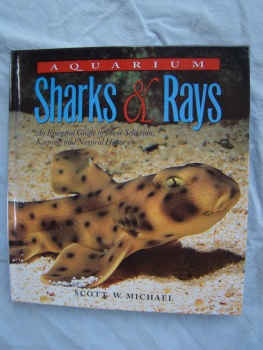
By Bob Goemans

TITLE: Aquarium Sharks & Rays
AUTHOR: Scott W. Michael
PUBLISHER: Microcosm/T.F.H. (2001)
ISBN 1-890087-57-2
PAGES: 256
PRICE: $44.95 (Hardcover)

SHARKS actually not one of my favorite subjects! And, how right Martin Moe Jr. is when he writes in the Foreword about no other animal creating such fear in the human mind. My mind was and remains one of those! I was born and raised in the Long Island New York area and spent many hours swimming in the Amityville area. Of course the movie 'Jaws' later made that area famous. In fact, I still remember lifting my feet off the movie showroom floor during one of its more frightening scenes. I can also remember being frightened out of the water while snorkeling in highly turbid waters in the South China Sea when a 'very' large animal brushed up against my submerged body. Thinking 'shark' caused me to walk a quarter mile along reef tops to get back to dry land.
Yet, for those interested in keeping smaller species of sharks and rays, you'll thoroughly enjoy reading Scott's new book, which is 'An Essential Guide to Their Selection, Keeping, and Natural History.'
Following the brief 'Foreword,' written by Martin Moe Jr., 'Acknowledgments' pays tribute to those who have helped Scott write and publish this excellent work. The 'Introduction' follows where he introduces some elasmobranch facts along with the purpose of the book to give some insight into the biology and husbandry of these special animals. It also clearly defines what species can adequately be cared for in the home aquarium. Moreover, it also serves as a platform to discuss the ethics associated with keeping these animals, of which, I found to be truly down-to-earth commonsense logic.
There are eight chapters, with Chapter 1 'Basic Anatomy' discussing the overall body unit. Its subsections are titled: Body Plans; Fins; Buoyancy Control; The Brain; Shark Senses; Respiration; Jaws, Teeth, and Diet; Digestive System; and, Skin and Coloration. They all present a very factual look at what is often termed the world's greatest predator.
Chapter 2 'The Elasmobranch Aquarium System' provides the information needed to plan and set up an adequate aquarium system for these large animals. Its subsections encompass the shape and size of tanks for different species, filtration, the need for good protein skimming, substrate requirements, aquascaping, lighting, water parameters, and a page dedicated to cold-water sharks. All in all the necessary groundwork for anyone wanting to maintain these creatures.
Of course no book on this subject matter would be complete without a chapter dedicated to 'Selecting the Right Specimen,' which just happens to be the title of Chapter 3. In my opinion, even though this chapter is only seven pages, it's the most important in the book. It contains a list of the ten common selection mistakes along with the best sharks and rays for beginners. Sharks and rays for experts, and subsections pertaining to swimming behavior and habitat preferences also compliment the chapter.
Chapter 4 'A Catalog of Sharks & Rays' is lengthy, taking up almost 100 pages because it is dedicated to the captive care of all the individual species of interest.
Chapter 5 "Swimming with the Sharks & Rays' complements Chapter 3 since it discusses what should 'not' be selected or housed as tankmates.
Of course, 'Foods & Feeding' is of major importance and happens to be the title of Chapter 6. Feeding frequency, guidelines, growth rates, nutritional and mineral deficiencies, fasting, recommended foods, and forced feedings are among its subject matter.
Chapter 7 'Elasmobranch Health' goes into recognizing and coping with common disease and nutritional problems. It looks at different forms of parasitic infestations, e.g., protozoans and dinoflagellates, flatworms, nematodes, leeches, along with copper sensitivity. Bacterial infections and some drug treatments are also discussed along with miscellaneous situations such as what needs to be accomplished to successfully ship/transport sharks and rays.
Chapter 8 'Captive Reproduction' contains advice for the 'would-be' elasmobranch breeder. Selecting and hatching shark eggs was a most interesting section. Reproductive behavior and breeding of various shark species of interest along with field observations on the mating behavior of the round stingray is also discussed.
The work closes with a Glossary, Contacts, Bibliography, Photograph & Illustration Credits, Index, About the Author, and The Aquarium Suitability Index.
Before I close, the quality of photographs we have grown accustom to from Microcosm and the literary excellence associated with TFH publications has
been again brought together to present Scott's outstanding work. It's truly a win-win situation for all, including the animals in the aquarium!
In conclusion, Aquarium Sharks & Rays, An Essential Guide to Their Selection, Keeping, and Natural History is a well-written, informative, beautifully illustrated publication. For those of you now maintaining shark and/or ray enclosures, or those considering future similar endeavors, this book deserves to be thoroughly read so the right choices are made and these creatures have what is needed for their continued well being.